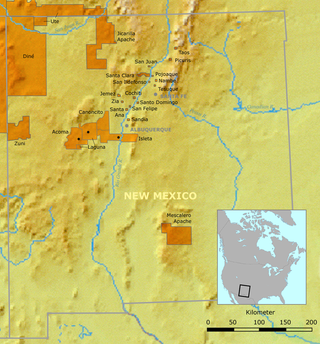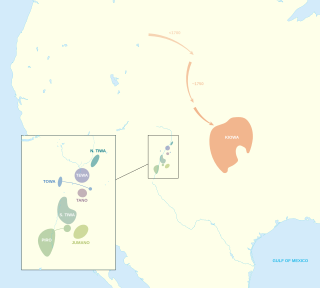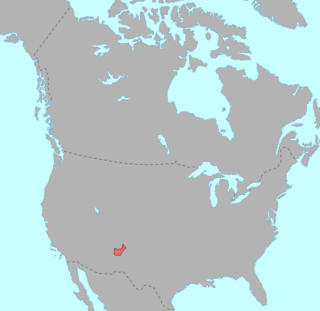
The Puebloans, or Pueblo peoples, are Native Americans in the Southwestern United States who share common agricultural, material, and religious practices. Among the currently inhabited Pueblos, Taos, San Ildefonso, Acoma, Zuni, and Hopi are some of the most commonly known. Pueblo people speak languages from four different language families, and each Pueblo is further divided culturally by kinship systems and agricultural practices, although all cultivate varieties of maize.
In phonetics, ejective consonants are usually voiceless consonants that are pronounced with a glottalic egressive airstream. In the phonology of a particular language, ejectives may contrast with aspirated, voiced and tenuis consonants. Some languages have glottalized sonorants with creaky voice that pattern with ejectives phonologically, and other languages have ejectives that pattern with implosives, which has led to phonologists positing a phonological class of glottalic consonants, which includes ejectives.
Hopi is a Uto-Aztecan language spoken by the Hopi people of northeastern Arizona, United States.

The alveolar and dental ejective stops are types of consonantal sound, usually described as voiceless, that are pronounced with a glottalic egressive airstream. In the International Phonetic Alphabet, ejectives are indicated with a "modifier letter apostrophe" ⟨ʼ⟩, as in this article. A reversed apostrophe is sometimes used to represent light aspiration, as in Armenian linguistics ⟨p‘ t‘ k‘⟩; this usage is obsolete in the IPA. In other transcription traditions, the apostrophe represents palatalization: ⟨pʼ⟩ = IPA ⟨pʲ⟩. In some Americanist traditions, an apostrophe indicates weak ejection and an exclamation mark strong ejection: ⟨k̓, k!⟩. In the IPA, the distinction might be written ⟨kʼ, kʼʼ⟩, but it seems that no language distinguishes degrees of ejection.

Tanoan, also Kiowa–Tanoan or Tanoan–Kiowa, is a family of languages spoken by indigenous peoples in present-day New Mexico, Kansas, Oklahoma, and Texas.

Zuni is a language of the Zuni people, indigenous to western New Mexico and eastern Arizona in the United States. It is spoken by around 9,500 people, especially in the vicinity of Zuni Pueblo, New Mexico, and much smaller numbers in parts of Arizona.

Keres, also Keresan, is a Native American language, spoken by the Keres Pueblo people in New Mexico. Depending on the analysis, Keres is considered a small language family or a language isolate with several dialects. The varieties of each of the seven Keres pueblos are mutually intelligible with its closest neighbors. There are significant differences between the Western and Eastern groups, which are sometimes counted as separate languages.

The Tewa are a linguistic group of Pueblo Native Americans who speak the Tewa language and share the Pueblo culture. Their homelands are on or near the Rio Grande in New Mexico north of Santa Fe. They comprise the following communities:

Chakwaina is a kachina which appears in Hopi, Zuni, and Keresan ceremonies, but does not appear in Tewa ceremonies. Although imagery of the kachina is varied, it is usually depicted as an ogre, with ferocious teeth and a black goatee and black mask with yellow eyes. Its spread throughout Pueblo culture is often associated with the Asa clan.
The Hopi-Tewa are a Tewa Pueblo group that resides on the eastern part of the Hopi Reservation on or near First Mesa in northeastern Arizona.

The Pueblo clowns are jesters or tricksters in the Kachina religion. It is a generic term, as there are a number of these figures in the ritual practice of the Pueblo people. Each has a unique role; belonging to separate Kivas and each has a name that differs from one mesa or pueblo to another.
Taos is a Tanoan language spoken by several hundred people in New Mexico, in the United States. The main description of its phonology was contributed by George L. Trager in a (pre-generative) structuralist framework. Earlier considerations of the phonetics-phonology were by John P. Harrington and Jaime de Angulo. Trager's first account was in Trager (1946) based on fieldwork 1935-1937, which was then substantially revised in Trager (1948). The description below takes Trager (1946) as the main point of departure and notes where this differs from the analysis of Trager (1948). Harrington's description is more similar to Trager (1946). Certain comments from a generative perspective are noted in a comparative work Hale (1967).
Picuris is a language of the Northern Tiwa branch of Tanoan spoken in Picuris Pueblo, New Mexico.
The phonology of the Zuni language as spoken in the southwestern United States is described here. Phonology is a branch of linguistics that studies how languages or dialects systematically organize their sounds.

The indigenous languages of the Americas form various linguistic areas or Sprachbunds that share various common (areal) traits.
Arizona, a state in the southwestern region of the United States of America, is known for its high population of Native Americans. Arizona has the third highest number of Native Americans of any state in the Union. Out of the entire US population of 2.9 million Native Americans, roughly 286,680 live in Arizona, representing 10% of the country's total Native American population. Only California and Oklahoma have more Native Americans than Arizona by number. Arizona also has the highest proportion of land allocated to Native American reservations, at 28%. Arizona has five of the twelve largest Indian reservations in the United States, including the largest, the Navajo Nation, and the third-largest, the Tohono O'odham Nation. Also, Arizona has the largest number of Native American language speakers in the United States.

Paul V. Kroskrity is an American linguistic anthropologist known primarily for his contributions to establishing and developing language ideology as a field of research. He is professor of anthropology, applied linguistics, and American Indian Studies at the University of California, Los Angeles. He is the past President of the Society for Linguistic Anthropology and past Chair of the American Indian Studies program at the University of California, Los Angeles.
Bertha Pauline Dutton was an American anthropologist and ethnologist specializing in the American Southwest and Mesoamerica. She was one of the first female archeologists to work with the National Park Service.

Astialakwa was a prehistoric and historic village built by the ancestral Puebloan people located within the Astialakwa Archeological District, in an area now known as the Jemez Springs area of Northern New Mexico. The archeological area is on the National Register of Historic Places. The location is restricted from access.